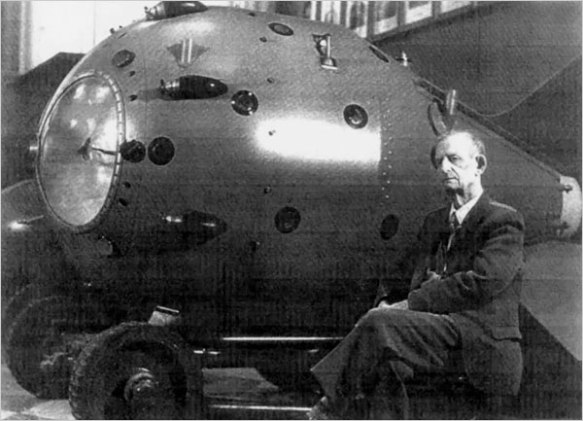The Soviet Union decided to start to build an atomic bomb during WWII when Stalin received a letter from a physicist named Georgy Flyorov.
The Soviet nuclear research program, later code-named “Operation Borodino,” was accelerated in 1943 with detailed research information provided by communist sympathizers such as Klaus Fuchs, inside the Manhattan Project at Los Alamos in New Mexico. Beria himself, although suspicious of his own spies and the Soviet scientists, began to take over supervision of nuclear research from Molotov and brought Professor Igor Kurchatov’s team under complete NKVD control.
The Soviet program’s main handicap, however, was a lack of uranium ore. On Beria’s instructions, the Soviet Purchasing Committee in the United States asked the American War Production Board to sell it uranium oxide. After consultation with Major General Groves, the head of the Manhattan Project, the U.S. government authorized purely token supplies, mainly in the hope of finding out what the Soviet Union was up to. Groves, meanwhile, was already working to ensure that the United States and Britain would have a virtual monopoly of the world uranium supply after the war, especially for the richest deposits of all in the Belgian Congo. But this plan was betrayed to the NKVD, most probably by the British traitor Donald Maclean, then working in Washington, D.C., on the Combined Policy Committee. On February 28, 1945, just as the Soviet forces earmarked for the capture of Berlin were securing their northern flank in Pomerania along the Baltic, Beria received a detailed report on every aspect of research in the United States, including the Groves plan. The idea that the western Allies wanted to deprive the Soviet Union of uranium after the war must have excited Stalin’s deepest suspicions. Fresh uranium deposits in Kazakhstan were confirmed at just about that time, but still in insufficient quantities. The Soviet Union’s only hope of copying the American atomic bomb lay in seizing German supplies of uranium before the western Allies got to them. Beria had discovered from Soviet scientists who had worked up to 1933 at the Kaiser Wilhelm Institute for Physics in Dahlem, a southwestern suburb of Berlin, that this was the center of German atomic research. Work was carried out there in a lead-lined bunker known as the “Virus House,” a code name to discourage outside interest. Next to this bunker stood the Blitzturm, or “tower of lightning,” which housed a cyclotron capable of creating 1.5 million volts. Beria, however, did not know that most of the Kaiser Wilhelm Institute’s scientists, equipment, and material, including seven tons of uranium oxide, had been evacuated to Haigerloch in the Black Forest. But a German bureaucratic mix-up had led to a further large consignment of uranium oxide being sent to Dahlem instead of Haigerloch.
Stalin saw the capture of Berlin as the Soviet Union’s rightful reward, but the yield was disappointing and the waste terrible. A key target was the Reichsbank in Berlin. Serov accounted for 2,389 kilos in gold, twelve tons of silver coin and millions in banknotes from countries which had been occupied by the Axis. Yet the bulk of Nazi gold reserves had been moved westwards. Serov, however, was later accused of having also held back a certain proportion of the proceeds for the NKVD’s `operational expenses’.
The main objective was to strip Germany of all its laboratories, workshops and factories. Even the NKVD in Moscow provided a shopping list of items wanted from police forensic laboratories. The Soviet atomic programme, Operation Borodino, had the very highest priority of all, but considerable efforts were also made to track down V-2 rocket scientists, Siemens engineers and any other skilled technicians who could help the Soviet armaments industry catch up with the United States. Only a few, such as Professor Jung and his team who refused to help on nerve gas, managed to resist Soviet pressure. Most of the others enjoyed comparatively privileged conditions and the right to bring their families with them to the Soviet Union.
German scientific equipment, however, turned out to be rather less tractable than its human designers. The vast majority of items taken back to Moscow were of no use because they required an environment suitable for precision engineering and the purest raw materials. ‘Socialism cannot benefit itself,’ observed one of the Soviet scientists involved in stripping Berlin, `even when it takes the whole of another country’s technological infrastructure.’
Most of the programme of stripping laboratories and factories was marked by chaos and disaster. Red Army soldiers who discovered methyl alcohol drank it and shared it with their comrades. The contents of workshops were ripped out by working parties of German women, then left in the open, where they rusted. Even when finally transported back to the Soviet Union, only a small proportion was ever put to good use. Stalin’s theory of industrial expropriation showed itself to be worse than futile. And this came on top of the Red Army’s less than enlightened attitude towards German property in general. French prisoners of war were astonished at `the systematic destruction of machinery in good repair which could be reused’. It was a huge dissipation of resources and condemned Soviet-occupied Germany to a backwardness from which it never recovered.
